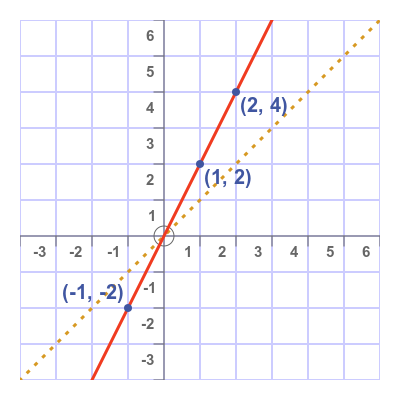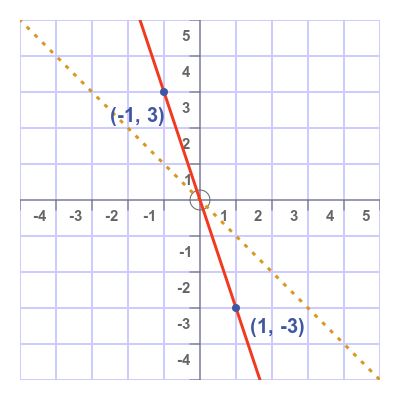Graphs of sloping lines through the origin
Categories: gcse graphs

In this section, we will look at the graphs of sloping straight lines that go through the origin.
These lines all have the equation:
$$ y = a x $$
but use different values for a.
The line y = 2x
This graph shows a graph of the straight line y = 2x:

We can calculate points that are on the line, using the formula. We simply chose an x-value (for example 2), and multiply it by 2 to get the y-value (which would be 4). Here are some other points that are marked on the graph:
- (-1, -2)
- (1, 2)
- (2, 4)
The dashed yellow line has the equation y = x. We can see that the line y = 2x is steeper than the line y = x.
The line y = ⅓x
This graph shows a graph of the straight line y = ⅓x:

Again, we can calculate points that are on the line. We simply chose an x-value (for example 3), and multiply it by one third.
Multiplying by one third is the same as dividing by 3, so this would give a y-value of 1. Here are some other points that are marked on the graph:
- (3, 1)
- (6, 2)
We can see that this time the line is less steep than the line y = x.
Using negative values
We can use a negative multiplier, for example, y = -3x. In this case, if we take an x-value of 1, we get a y-value of -3. Similarly, for an x-value of -1, we get a y-value of 3.
Here is the graph:

This line slopes downwards. Compared to the dashed yellow line y = -x, the line y = -3x is steeper but in the negative direction.
Here is a graph of the equation y = -½x:

This graph goes through the points (-4. 2) and (4, -2), calculated in the same way as before. This time the curve is less steep than y = -x.
Rules
- A straight line passing through the origin has the equation y = ax.
- If a is positive the line slopes upwards.
- If a is negative the line slopes downwards.
- The greater the absolute value of a, the steeper the slope.
See also

Join the GraphicMaths Newletter
Sign up using this form to receive an email when new content is added:
Popular tags
adder adjacency matrix alu and gate angle answers area argand diagram binary maths cartesian equation chain rule chord circle cofactor combinations complex modulus complex polygon complex power complex root cosh cosine cosine rule cpu cube decagon demorgans law derivative determinant diagonal directrix dodecagon eigenvalue eigenvector ellipse equilateral triangle euler eulers formula exercises exponent exponential exterior angle first principles flip-flop focus gabriels horn gradient graph hendecagon heptagon hexagon horizontal hyperbola hyperbolic function hyperbolic functions infinity integration by parts integration by substitution interior angle inverse hyperbolic function inverse matrix irrational irregular polygon isosceles trapezium isosceles triangle kite koch curve l system line integral locus maclaurin series major axis matrix matrix algebra mean minor axis n choose r nand gate newton raphson method nonagon nor gate normal normal distribution not gate octagon or gate parabola parallelogram parametric equation pentagon perimeter permutations polar coordinates polynomial power probability probability distribution product rule proof pythagoras proof quadrilateral questions radians radius rectangle regular polygon rhombus root sech segment set set-reset flip-flop sine sine rule sinh sloping lines solving equations solving triangles square standard curves standard deviation star polygon statistics straight line graphs surface of revolution symmetry tangent tanh transformation transformations trapezium triangle turtle graphics variance vertical volume volume of revolution xnor gate xor gate